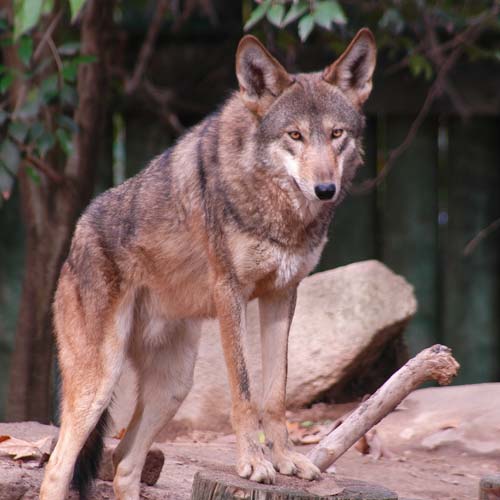The Most Endangered Wolf
Intermediate in size between the gray wolf (Canis lupus) and the coyote (Canis latrans), red wolves look something like large coyotes.
Range
Historical – Red wolves originally occupied eastern North America, from the Gulf Coast into southern Ontario, Canada. Current – Extinct in the wild in 1980, Red wolves are now in a captive breeding-and-release program. The primary wild release area is eastern North Carolina, on the peninsula between the Albermarle and Pamilico Sounds. Low human density, wetland soil type and distance from roads seem to be the most important habitat features.
Diet
- Wild – Rabbits, squirrels, fawns, birds and eggs, plus insects and reptiles as available.
- Zoo – Canine Maintenance, with frozen feline; fasted weekly; bone or muscle meat weekly.
Coloration
Red wolves are cinnamon or tawny, with black-tipped guard hairs. The ears are usually red and the tail-tip black. The summer coat is more reddish than the dense winter coat. In all seasons, the “eyebrows” and fur along the lips is cream.
Behavior
Red wolves seldom form large packs and mostly hunt smaller mammals like raccoons, rabbits, and deer. Red Wolves seldom howl, but when they do it is more reminiscent of coyote chortling. The young especially, do a lot of singing and chortling. Red Wolves are mostly nocturnal, but may be more active during the day in the winter.
Adaptation
Red Wolves have long thin legs, typical of running hunters. Hearing and vision are keen, necessary for being nocturnal predators, and the sense of smell is excellent.
There is a definite change in coat, summer being short and coarse, almost slick-coated, and winter being double and soft.
Breeding & Growth
Red Wolves mate for life. Gestation is about 60 days. Usually 4 altricial pups are born, the eyes opening after about 2 weeks. They begin joining the hunt at about 5 months, just after their deciduous canines drop out and the permanent ones begin to come in. Pups will stay with the pack for 1 to 3 years, helping to raise their younger siblings.
Animal Facts
- Lifespan 6-7 years in the wild and up to 15 years in captivity
- Length 4.5-5.5 feet long (including the tail)
- Height About 26 inches at the shoulders
- Weight 50-80 pounds
- Status Critically Endangered

